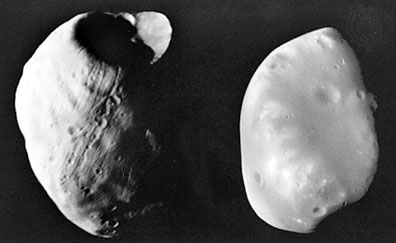
Viking orbiter photographs of (left) Phobos and (right) Deimos. The smooth texture of the surface of Deimos is contrasted with the grooved, pitted, and cratered surface of Phobos.

Viking orbiter photographs of (left) Phobos and (right) Deimos. The smooth texture of the surface of Deimos is contrasted with the grooved, pitted, and cratered surface of Phobos.
Deimos:
Deimos (Latin for Panic) is a moon of Mars and was named after an attendant of the Roman war god Mars. Deimos is a dark body that appears to be composed of C-type (blackish carbonaceous chondrite) surface materials. It is similar to the C-type asteroids that exist in the outer asteroid belt.
Deimos is the outer of the two satellites of Mars. Both these moons were discovered by the American astronomer Asaph Hall in 1877. A small, irregular, cratered body approximately 15x12x11 km (9x7x7 miles) across, Deimos circles the planet every 30.3 hours at a distance of 23,459 km (14,545 miles) in a circular orbit that lies within 2 degrees of Mars's equatorial plane. The satellite's longest axis is always directed toward Mars, making the spin period synchronous with the orbital one. The largest crater, located near the satellite's south pole, is about 2.5 km wide. Like that of its companion, Phobos, the surface of Deimos is gray and very dark (reflectance is only 7 percent, or about one-half that of the lunar surface). These facts and the satellite's low mean density (less than two grams per cubic centimetre) indicate a carbonaceous composition and suggest that Deimos may be a captured asteroid-like object. In spite of its tiny gravity (about 10-3 g), Deimos has retained considerable amounts of regolith on its surface.
Excerpt from the Encyclopedia Britannica without permission.